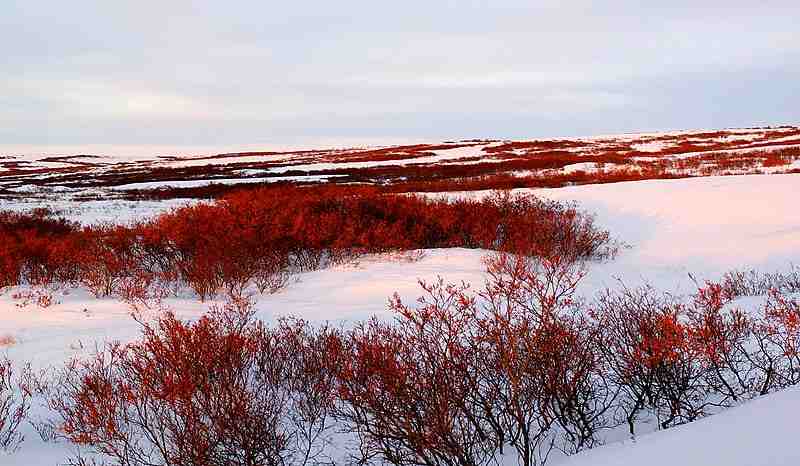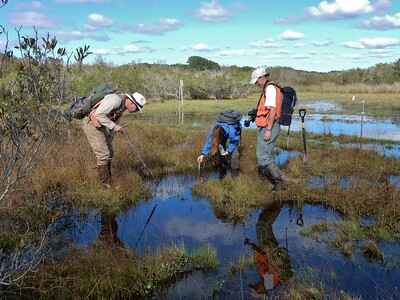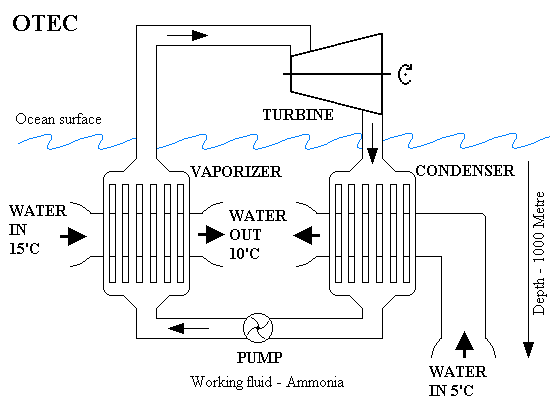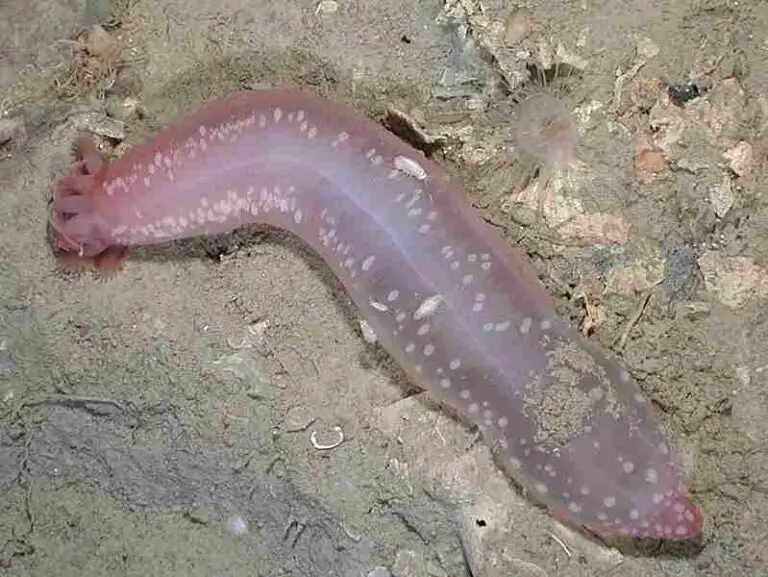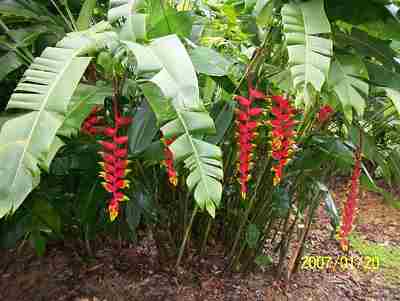5 Abiotic Factors in the Tundra and their Attributes Discussed
Abiotic factors in the tundra are; soil, water, physicochemical parameters (like temperature and pH), solar radiation, and atmospheric gases.
This article discusses abiotic factors in the tundra and their individual attributes, as follows;
1). Tundra Soil (as one of the Abiotic Factors in the Tundra)
The type of soil found in tundra ecosystem is cryosol; which is a mineral soil that originates from geological processed in frigid environments [4].
Tundra soils form under cryogenic (cold) conditions, where nutrient recycling and soil development occur at a relatively-slow pace due to the low temperatures.
*Composition of Tundra Soil
An important component of tundra soil is permafrost, which is a permanently-frozen layer that underlies the topmost layer of soil [3].

Permafrost in the tundra reduces infiltration of water into soil, thereby limiting the amount of water available to plant roots and soil organisms.
Soil in the tundra also undergoes cryoturbation; which refers to the churning and mixing of soil material as a result of alternate thawing and freezing cycles in summer and winter respectively.
The organic matter content of tundra soil is fairly high [2] in the topmost layer.
This is due to slow rate of biodegradation under frigid conditions.
Organic matter in tundra soil comprises mainly of plant biomass in the form of peat, formed by the accumulation of plant remains over a period of time.
Due to its high organic matter-content, tundra soil is considered an effective carbon sink. Organic matter also enhances moisture retention and nutrient content of the soil, respectively.
Mineral content of tundra soil is generally low, with essential nutrients like phosphorus, potassium and nitrogen occurring in small amounts.
Factors behind this attribute include slow biodegradation that limits nutrient-release (from degrading organic matter to the soil), as well as leaching.
*Tundra Soil Texture
Tundra soils have various textural characteristics from one specific zone or area to another.
The texture of soil in the tundra ranges from sandy and silty to clayey (or coarse to fine-grained), varying with factors like the nature of parent materials, and the intensity of cryoturbation.
Along with texture, other characteristics like sorting, drainage and moisture retention-capacity also vary from one tundra location or micro-habitat, to another.
*Structure, Horizons of Tundra Soil
The topmost layer of tundra soil is called the 'active' layer, and it freezes and thaws alternately in winter and summer seasons.
A characteristic of the tundra topsoil is its narrow depth/thickness.
It is crucial to root anchorage and nutrient cycling; being the main source of nutrients to tundra plants in the summer.
In spite of poor development, tundra soils have defined horizons that can be distinguished into layers O, A, B, and C; where O is the topmost humus layer, and the subsequent ones are mineral horizons with varied degrees of weathering, as well as composition and thickness.
Tundra soils may be waterlogged in some areas, especially during the summer.
Such waterlogged areas are called tundra wetlands, and their occurrence can be attributed to poor regional drainage imposed by permafrost.

2). Water in the Tundra
Water is an essential abiotic factor in the tundra biome that plays a key role in driving ecological processes and influencing physicochemical conditions within the terrain.
*Sources of Water in the Tundra
Three main sources of water in the tundra are; groundwater, precipitation, and ice-thaw.
Groundwater is fairly accessible in the tundra due to a shallow water table. Moisture in tundra wetlands and soils often come from underground aquifers.
Precipitation supplies water to recharge aquatic micro-habitats and groundwater aquifers in the tundra. The amount of precipitation received annually by the tundra is low compared to more-humid ecosystems like tropical rainforests.
Also, snowfall is the most common form of precipitation received by tundra ecoregions.

Ice-thaw can be used to refer to the process of snow-melting as well as the liquid water produced as a result of this process. In summer, ice-thaw serves as a source of water in the tundra, which flows into soil, streams, rivers, lakes and ponds.
*How Permafrost Affects Water Distribution and Regional Hydrology in Tundras
Permafrost refers to ground that is permanently frozen, usually occurring underneath the topsoil layer on the surface.
In the tundra, permafrost reduces ground permeability, and limits the dynamics of water such as infiltration. On a broad scale, this makes the tundra poorly-drained terrain, with less-active hydrological cycles and water-flow rates.
The topmost/active layer may be infiltrated by water, especially during the summer season when it thaws.
Water bodies in the tundra are surficial reservoirs that hold water especially after ice-thawing in summer. They serve as micro-habitats that contain aquatic organisms like fish and crustaceans.
*Importance of Water to the Tundra Ecosystem
The availability of water in the tundra, directly influences the sustainability of biotic components like tundra animals and plants.
The availability of water in the tundra is essential for plant growth.
Tundra plants are generally adapted to low temperature and limited water supply; having physiological and behavioral features for cold-tolerance and water conservation, respectively.
Adequate water in soil facilitates the growth of sedges, mosses, dwarf shrubs and grasses, in tundra regions.
Tundra animals including insects, mammals and birds; also depend on water for their survival. Most of these organisms have adaptations for drought-tolerance; which enables them survive.
Water is essential for the cycling of nutrients in the tundra; through its role in biodegradation and nutrient translocation.
Lastly, water drives some geological processes like erosion and weathering, which help shape the tundra landscape.

3). Solar Radiation (as one of the Abiotic Factors in the Tundra)
Solar radiation is an important abiotic factor in the tundra, that plays a role in shaping environmental conditions like the tundra climate.
As a result of its geographical situation in high-latitude zones, the tundra is subject to distinctive patterns of solar radiation.
Some trends in the supply of solar radiation in tundra ecoregions include;
1. Prolonged supply in summer, leading to unusually extensive daylight periods [1]
2. Limited supply in winter, leading to prolonged periods of darkness
*Seasonal Changes in Supply of Solar Radiation in the Tundra
Supply of solar radiation in the tundra varies on a seasonal basis.
In summer, the solar supply is almost infinitely-continuous; and this results in a phenomenon of extended daylight periods referred to as the midnight sun effect.

On the other hand, in winter; solar radiation is very limited; so that extensive periods of darkness occur. In some cases, full daylight may not occur for multiple weeks in a row.
*Insolation and Angularity of Solar Radiation in the Tundra
Insolation is a measure of the total amount of radiation from the sun, that is received per unit area in a given environmental system.
Summer insolation levels are far higher than winter, because of the drastic differences in intensity and duration of solar radiation.
Due to its high-latitudinal position, solar rays strike the tundra at an angle far from the normal (90°), unlike in equatorial zones where the angle of solar incidence is closer to the normal.
This condition of angularity increases the degree of interference of solar rays by atmospheric gases and moisture, and results in relatively-low solar intensity. Such observations help to explain the consistent, frigid nature of tundras in contrast to the warmth of most tropical rainforests.
*Solar Radiation as an Energy Medium in the Tundra
Solar radiation is the primary source of energy to the tundra.
This energy is captured by plants that use it to produce biomass through photosynthesis. The biomass produced is transferred from plants to animals in the tundra food chain.
Such an analogy indicates that the biological and physicochemical productivity of the tundra is directly proportional to the availability of solar radiation.
Plants that survive in the tundra are those whose adaptations enable them maximize limited sunlight for photosynthesis, as well as to conserve energy and water in winter, when these resources are rarely replenished.
Lastly, because solar radiation contains thermal energy (in infrared rays), it influences the environmental temperatures in tundras.
Solar availability, as already shown; is directly linked to winter and summer occurrences.
4). Physicochemical Parameters in the Tundra
Physicochemical parameters in the tundra are variables used to assess the physical and chemical conditions of tundra regions.
They are important abiotic factors because they determine the dynamics of inorganic processes. At the same time, physicochemical parameters govern many biological processes and organisms in the tundra and other ecosystems.
Examples of physicochemical parameters that play a role in the tundra's nature and conditions are;
1. Temperature
2. Humidity
3. Soil Moisture Content
4. pH
5. Salinity
6. Light Intensity
7. Nutrient Availability
8. Carbon Dioxide and Oxygen Levels
The physicochemical parameters of tundras are generally distinctive and can be used for characterization purposes.
This is exemplified by factors like relatively-low light intensity, variable salinity, low soil pH, low temperatures and low nutrient availability; all of which are typical of the tundra.
5). Atmospheric Gases (as one of the Abiotic Factors in the Tundra)
Atmospheric gases constitute another important abiotic factor in the tundra.
They can be described as the gases that measurably occur in the atmosphere above tundra areas, and they play an important role in wind propagation, climatic conditions, animal adaptations ad general ecology.
Examples of atmospheric gases are; oxygen (O2), nitrogen (O2), carbon dioxide (CO2), methane (CH4), and trace gases.
*Oxygen in the Tundra
In the tundra, oxygen is crucial for organic survival at all trophic levels, for all animal and plant groups, and in all micro-habitats.
Atmospheric proportion of oxygen is approximately 21% in the tundra.
*Nitrogen in the Tundra
In tundras and most parts of the world, nitrogen occurs as the most abundant atmospheric gas.
It is also an essential nutrient in soil, for plant growth.
The occurrence of nitrogen in mineral form, in tundra soil, can be attributed to a process called nitrogen fixation; whereby organisms like plants and bacteria convert atmospheric nitrogen to a storable resource [6].
*Carbon Dioxide in the Tundra
As a greenhouse gas, carbon dioxide is important to the global ecosystem for its influence on climate and its role in global warming.
The amount of atmospheric carbon dioxide available in the tundra can be traced to factors like soil processes, organic activity, and vegetation cover.
Because of cold climatic conditions, the tundra has a relatively-inactive carbon cycle that favors the accumulation and sequestration of carbon in large amounts (in form of organic matter) in frigid soil.
*Methane and Trace Gases in the Tundra
Methane is also a greenhouse gas that occurs in the atmosphere, in tundras.
Production of methane is a result of microbial activities and processes, which lead to the decomposition of organic matter. Such processes include anaerobic digestion that occurs in wetlands, waterlogged tundra soils, and other oxygen-deficient areas.
Also, the emission of methane from soil into the tundra atmosphere is influenced by permafrost; such that thawing is accompanied by increased rate of methane emission. This is one of the issues discussed in climate change analyses [5].
Traces gases in the tundra atmosphere include; ozone (O3) and water vapor (H2O), which result from hydrological processes and human-driven environmental impacts, like air pollution.
Conclusion
Abiotic factors in the tundra are;
1. Tundra Soil
2. Water
3. Solar Radiation
4. Physicochemical Parameters
5. Atmospheric Gases
References
1). Ashley, N. T.; Schwabl, I.; Goymann, W.; Buck, C. L. (2013). "Keeping time under the midnight sun: behavioral and plasma melatonin profiles of free-living Lapland longspurs (Calcarius lapponicus) during the arctic summer". J Exp Zool A Ecol Genet Physiol. 2013 Jan;319(1):10-22. Available at: https://doi.org/0.1002/jez.1768. (Accessed 16 June 2023).
2). Dai, X. Y.; Ping, C.-L.; Michaelson, G. J. (2002). "Characterizing soil organic matter in Arctic tundra soils by different analytical approaches." Organic Geochemistry 33(4):407-419. Available at: https://doi.org/10.1016/S0146-6380(02)00012-8. (Accessed 16 June 2023).
3). Höfle, S.; Rethemeyer, J.; Mueller, C. W.; John, S. (2013). "Organic matter composition and stabilization in a polygonal tundra soil of the Lena Delta." Biogeosciences 10(5). Available at: https://doi.org/10.5194/bg-10-3145-2013. (Accessed 16 June 2023).
4). Kaverin, D.; Pastukhov, A.; Lapteva, E. M.; Biasi, C.; Marushchak, M. E.; Martikainen, P. J. (2016). "Morphology and properties of the soils of permafrost peatlands in the southeast of the Bol’shezemel’skaya tundra." Eurasian Soil Science 49(5):498-511. Available at: https://doi.org/10.1134/S1064229316050069. (Accessed 16 June 2023).
5). Rößger, N.; Sachs, T.; Wille, C.; Boike, J.; Kutzbach, L. (2022). "Seasonal increase of methane emissions linked to warming in Siberian tundra." nature research, Nature Climate Change 12(11):1-6. Available at: https://doi.org/10.1038/s41558-022-01512-4. (Accessed 16 June 2023).
6). Zielke, M.; Solheim, B.; Spjelkavik, S.; Olsen, R. A. (2005). "Nitrogen Fixation in the High Arctic: Role of Vegetation and Environmental Conditions." Arctic Antarctic and Alpine Research 37(3):372-378. Available at: https://doi.org/10.1657/1523-0430(2005)037[0372:NFITHA]2.0.CO;2. (Accessed 16 June 2023).
